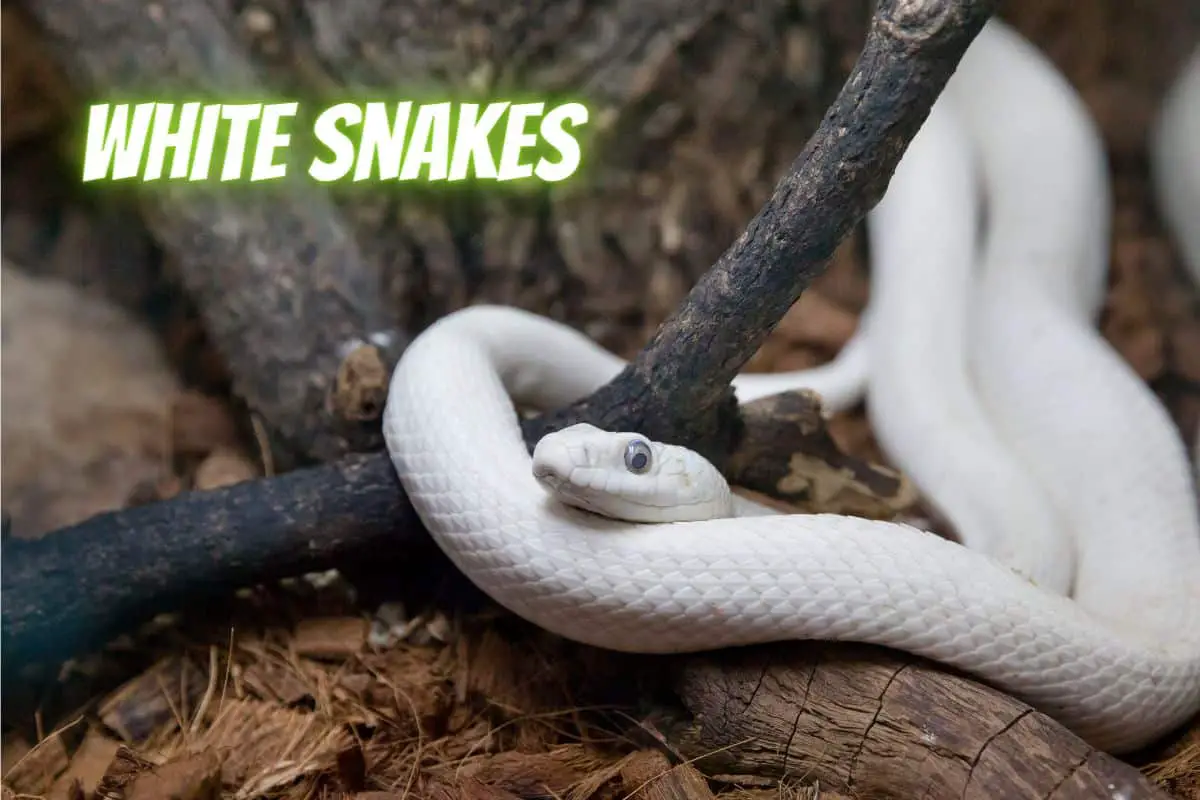The Best White Snakes to Keep as Pets
I’ve kept pet snakes and other reptiles for over 30 years and in that time I’ve been fortunate enough to have kept some of the most beautiful and unique snakes that I could find.
But for many people, myself included, the allure of an all white snake was irresistible!
Fast forward a number of years and the all-white ball python stormed onto the scene!
As breeders gained access to more and more morphs, selectively bred color and pattern combinations, they were able to breed many snakes to exhibit all white or mostly white coloration.
The Top 10 most popular and beautiful white snakes in the reptile hobby are as follows;
- Blue-eyed Lucy (Leucistic Ball Python)
- Ivory Ball Python
- Pied Ball Python
- Albino California Kingsnake
- Blizzard Corn Snake
- Super Phantom Reticulated Python
- Leucistic Rainbow Boa
- Snow Western Hognose
- Snowflake Leucistic Texas Rat Snake
- Leucistic Cobra
White snakes are either albinos, leucistics, or the resulting combination of the two. Finding a white snake in the wild is very rare.
In fact, the search for a white ball python went on in Africa for years until one was found and then sold in the US for over $150,000!!
Fortunately for us, ball pythons, boa constrictors (and other snakes) have been selectively bred to increase and intensify their white coloration and the prices and availability of these snakes have become attainable for most every reptile enthusiast!
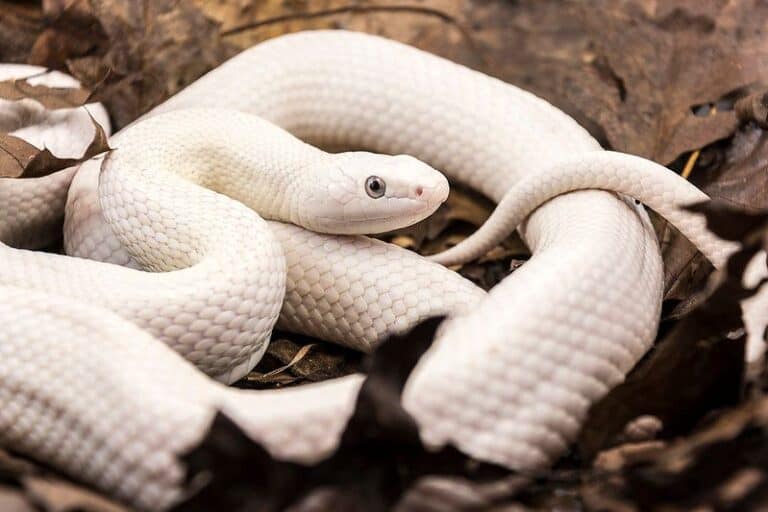
Reptile Roommate is a participant in the Amazon Services LLC Associates Program. As an Amazon Associate I earn from qualifying purchases.
Where Do White Snakes Come From?
All animals, people included, carry genes in their DNA that make us who we are.
For example in humans our genes determine our hair color and the color of our eyes, as well as whether or or not we’ll grow taller or shorter than average.
The same kinds of genes are found in snakes and reptiles too.
Sometimes these genes can have mutations that produce variations in the animal; albinism is one such mutation that prevents the production of the pigment (melanin) that gives the snake its color.
This lack of pigmentation results in a “bleached” look or white coloration.
Albino vs Leucistic
Albinism is the absence of melanin which is one type of pigmentation that gives skin its color. Leucism, on the other hand, is a partial loss of all types of pigmentation.
Albinism In Snakes
Albinism in snakes prevents the production of melanin, however melanin isn’t the only color-producing pigment that snakes make.
Snakes also produce carotenoids which are red-orange pigments but these carotenoids are not affected by albinism which is why many albino snakes are white with yellow(ish) coloration.
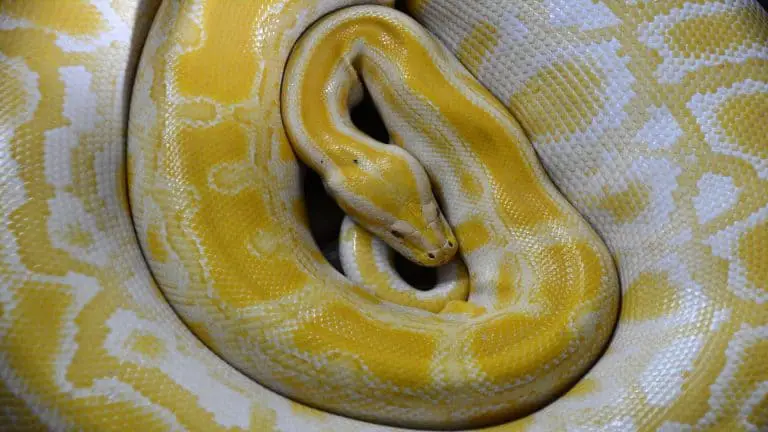
Fact: | All albino animals will exhibit red or pink eyes because the blood vessels in the eye show through the now colorless iris!
Leucism In Snakes
A leucistic snake loses (or partially loses) both melanin and carotenoid production resulting in a snake that is completely white, white patches and/or spots, or muted coloration with white background.
Unlike albinism, leucism does not affect pigmentation in the iris and the red eye coloration is absent.
Many truly pure white snakes are leucistic morphs because albino animals still produce those red-orange colors by the way of carotenoids.
White Snakes In the Wild
White snakes are quite rare in the wild because snakes are predators, stealthily sneaking up on their prey or camouflaging themselves into their surrounding environment and ambushing prey animals that venture too close!
…a bright white snake tends to stand out and it can make being a successful predator quite difficult; not to mention that a white snake can also stand out to other predators and become a meal for someone else!
In order to supply the reptile hobby with enough white snakes as is demanded by keepers, breeders had to step in and learn to “create” these snakes and make them much more available.
Selective Breeding to Create Pure White Snakes
Breeders who were lucky enough (or spent enough money) were able to obtain the very rare wild albino and leucistic animals and soon after added them to their breeding programs.
In this way, through repetitive breeding and over many generations, albino and leucistic snakes become more and more available.
Hobbyists demanded whiter and whiter snakes and those with little to no secondary coloration, so to fill this need breeders began to utilize selective breeding in order to improve their stock.
Since albino snakes can show some red to orange coloration and leucism can present itself in partial pigment loss (across all colors) obtaining a pure white snake would still be very difficult. This is where selective breeding comes into play.
For instance, breeders choose the “best” or the “whitest” albino ball python and then breed that animal to another very white (or low red-orange color) ball python in the hopes that the two snakes’ offspring will exhibit the very “best” or “whitest” color combination of both parents.
This is exactly how different breeds of dogs are “created,” you breed shorter and shorter dogs together to end up with a very small dog, etc, etc.
The same goes for trying to produce the completely white or mostly white snakes.
The ‘best of the best,’ those that show the greatest potential for all white coloration, are bred together over many generations to produce all white snakes.
These white snakes are not just limited to ball pythons, many snake species can now be found in white!
In general, leucistic snakes will show the most complete and brightest white coloration and high quality albino animals will be very bright white with a bright yellow or orange pattern.
Both types of snakes are absolutely stunning!!
How Much Do White Pet Snakes Cost?
White snakes, whether they be white with areas of color such as pieds or pure white like a Blue eyed Lucy, are the result of careful and deliberate breeding projects.
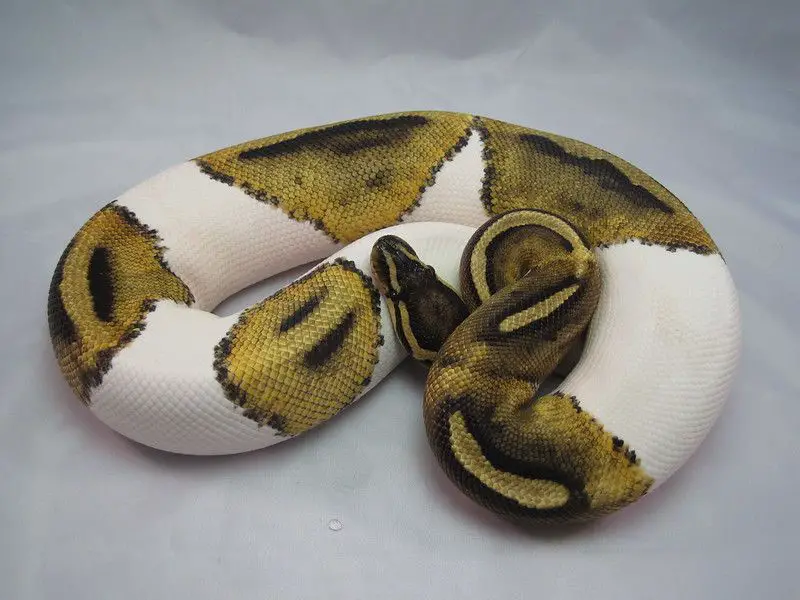
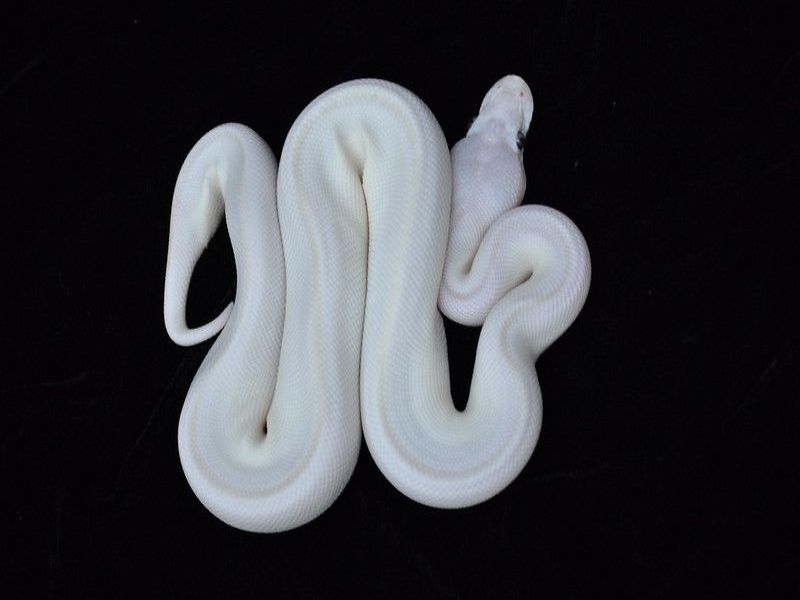
These breeding projects are expensive to start and require years of selectively breeding and raising up offspring therefore, white snakes command a premium price! You can expect to pay several hundred to several thousand dollars more for an all white snake than you would an average colored specimen of the same species!
You can expect to pay from $600 to upwards of $1,500 for a Blue-eyed Leucistic ball python depending on degree and quality to its white coloration while a Super Phantom reticulated python will cost $2500+!!
A Blizzard corn snake will cost anywhere from $200 to $300 and a leucistic rat snake approximately $200 and high white pied ball pythons can be found for $550 to over $10,000 depending on quality and the combination of other morphs in the mix!
Blue-Eyed Lucy (Leucistic Ball Python)
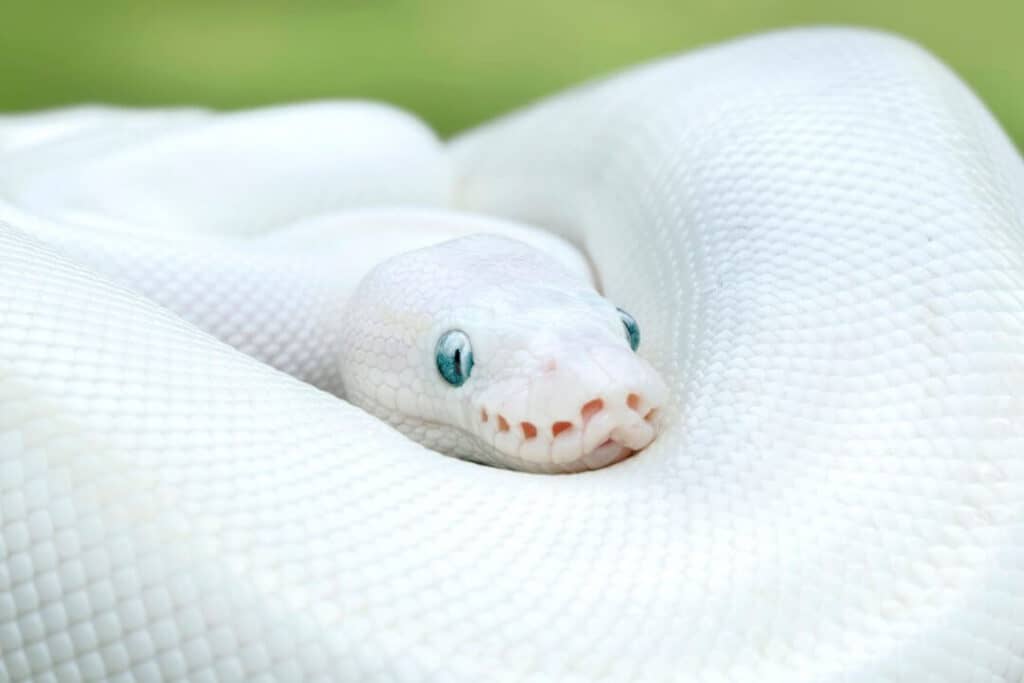
Leucistic ball pythons, or the blue-eyed Lucy, has to be the most striking all-white snake in existence!
The blue-eyed Lucy is an incredibly popular ball python morph and it’s easy to see why; from its striking ice-blue eyes to that pure white body these white snakes are highly sought after and make amazing additions to one’s reptile collection!
Ivory Ball Python
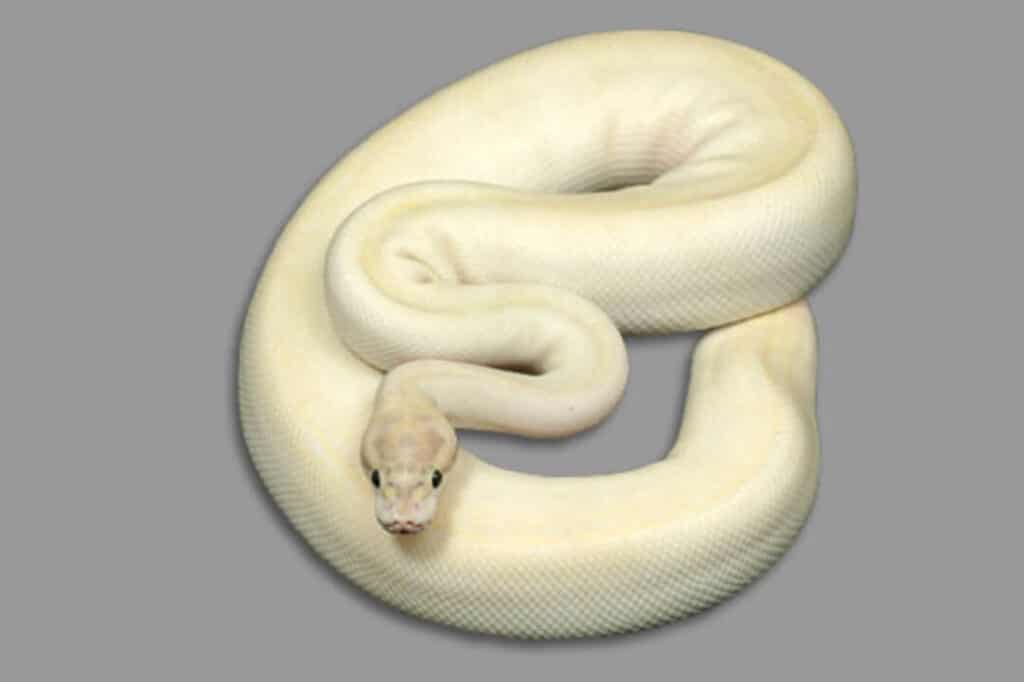
Ivory ball pythons are another very popular morph and make excellent pets! Ivories aren’t quite as “white” as a blue-eyed Lucy however their beautiful and creamy ivory coloration has made them a fan favorite for many years!
Not to mention the ivory ball’s off-white coloration makes an excellent addition to a collection features pure white snakes. Variety is the spice of life!
Pied Ball Python
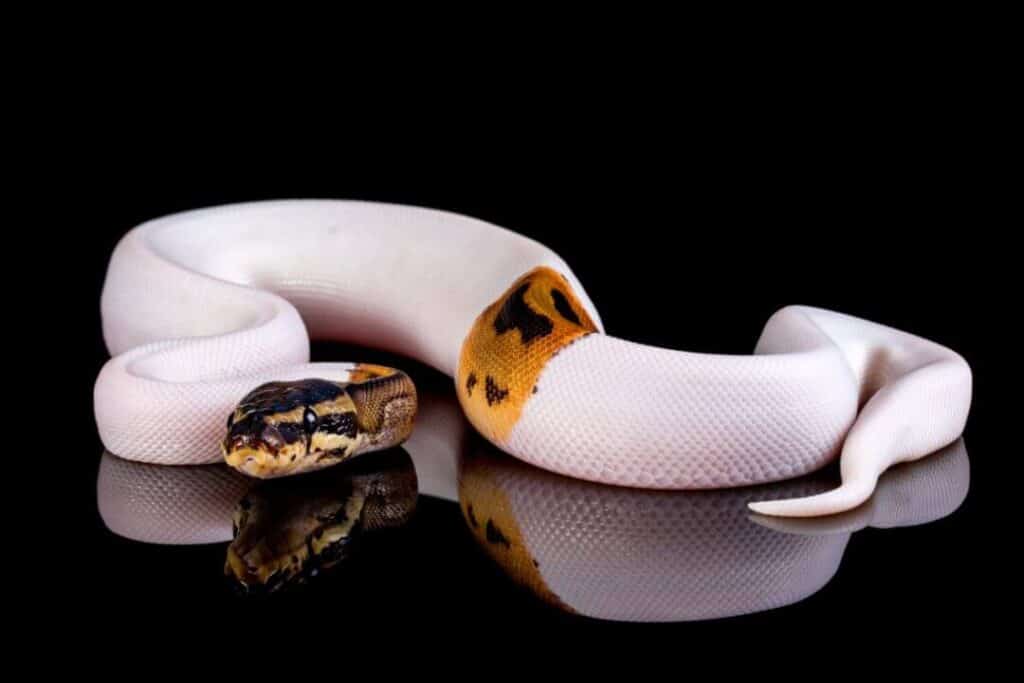
Pied ball pythons were all the rage when they first hit the market years ago. They have held onto their popular over the decades and while being relatively common now, pieds are still a top pick for many ball python keepers!
Pieds are unusual in that their white coloration comes in distinct bands or blocks along the snakes body. The amount of the white banding or blocks depends on the individual snake and its genetics!
Albino California Kingsnake
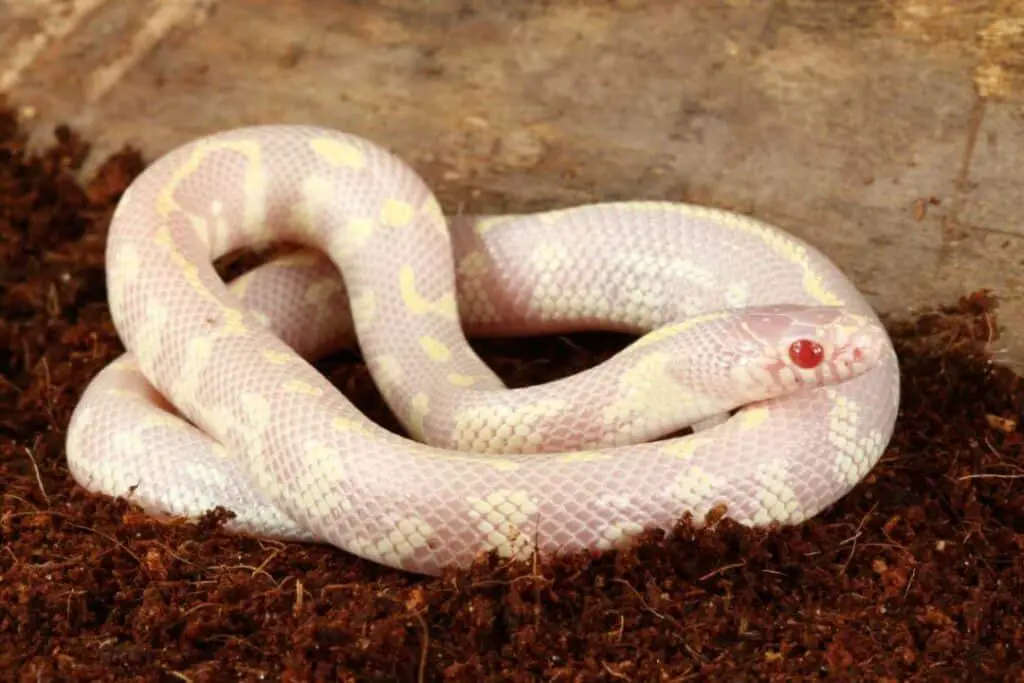
Kingsnakes are very popular pets and are kept by beginners as well as seasoned reptile keepers. What’s better than a California Kingsnake? …an albino California kingsnake of course!
Albino California Kingsnake’s coloration comes from recessive genes. There are two genes responsible for albinism in California kingsnakes; Albino T+ and Albino T-.
Albino T+ snakes have light base colors with no dark markings and normal colored eyes. Albino T- snakes on the other hand lack melanin altogether. These kingsnakes have very light colored markings and have pink eyes.
Blizzard Corn Snake
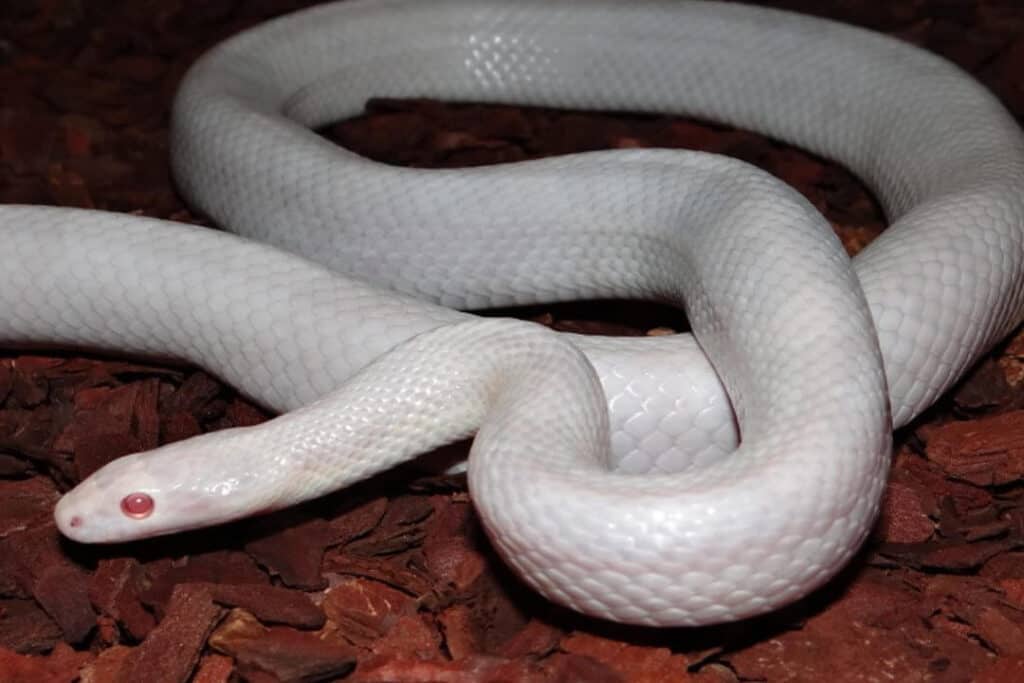
Blizzard corn snakes are prized for their white (sometimes cream) coloration all packaged in an easy-to-care-for ‘corn snake body’!
Corn snakes are great beginner snakes because they are great eaters, very hardy and a good size compared to much smaller and much LARGER snakes.
Add together the ease of care along with the striking white coloration, and you have a match made in snake heaven!
Super Phantom Reticulated Python
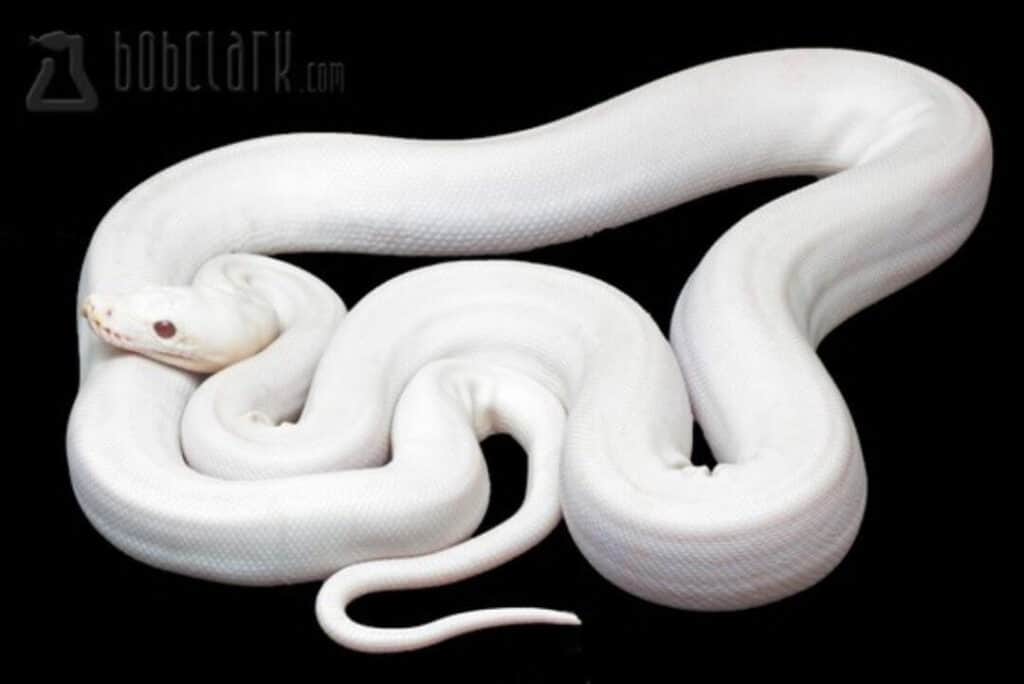
If you are looking for an all white snake AND you want a snake that gets HUGE, look no further than the Super Phantom morph of the reticulated python!
Reticulated pythons are some of the largest snakes available in the hobby and the white Super Phantom is considered by many to be one of the very best morphs of these incredible snakes.
As with any giant snake, Super Phantom reticulated pythons are best left to experienced hobbyists that can both handle and house such a huge reptile.
Leucistic Rainbow Boa
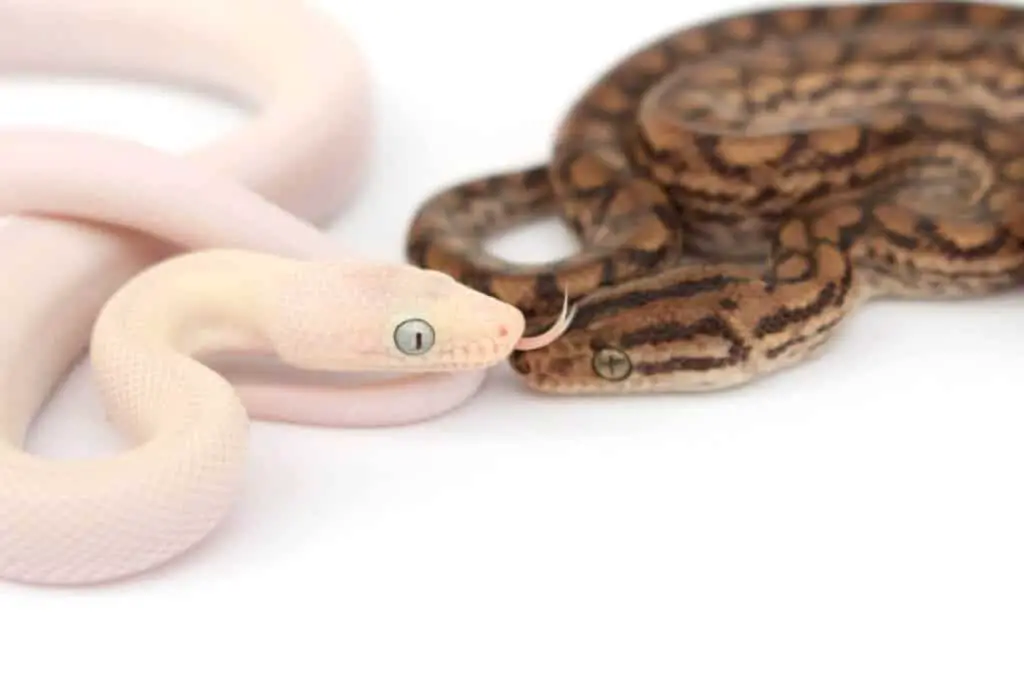
Brazilian rainbow boas might best be known for their brilliant iridescent sheen that reflects hues of blue, green and purple.
However, for some the leucistic (white) morph/coloration, is highly desirable.
Rainbow boas grow to a more manageable size than a boa constrictor or imperator and for this reason they are popular with reptile keepers.
Snow Western Hognose
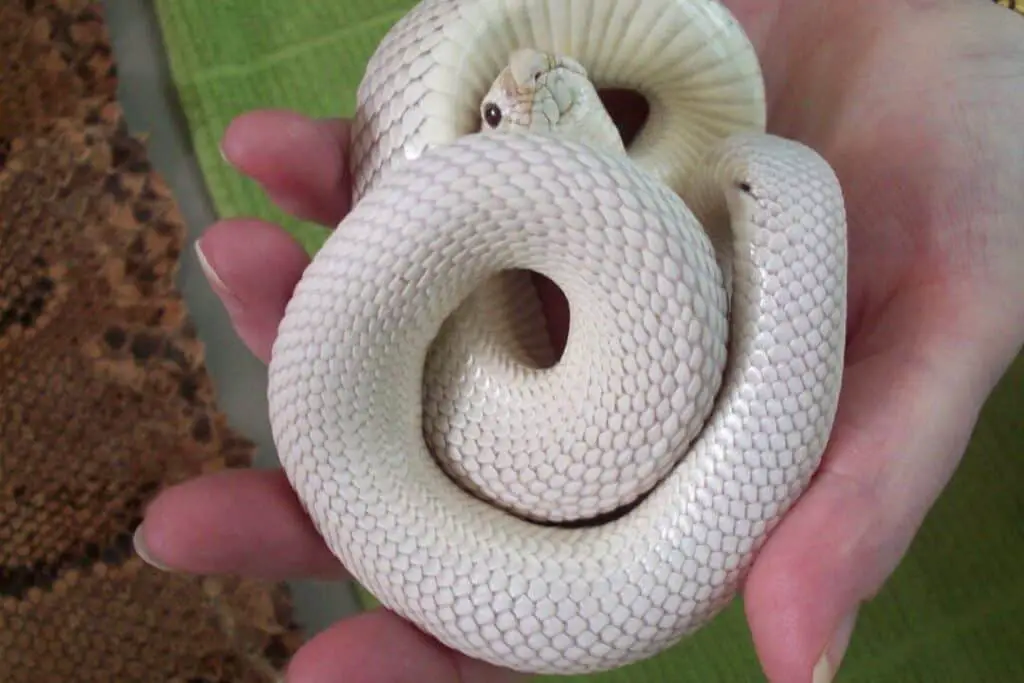
Hognose snakes are an excellent choice for most any reptile keeper! They stay a smaller, manageable size and their care is relatively straightforward and simple.
The Snow morph of this species is an absolutely beautiful white snake with occasional pink to purple undertones.
Western hognose are cute with their “puffed up angry” attitude or its comically adorable “play dead routine.”
Snowflake Leucistic Texas Rat Snake
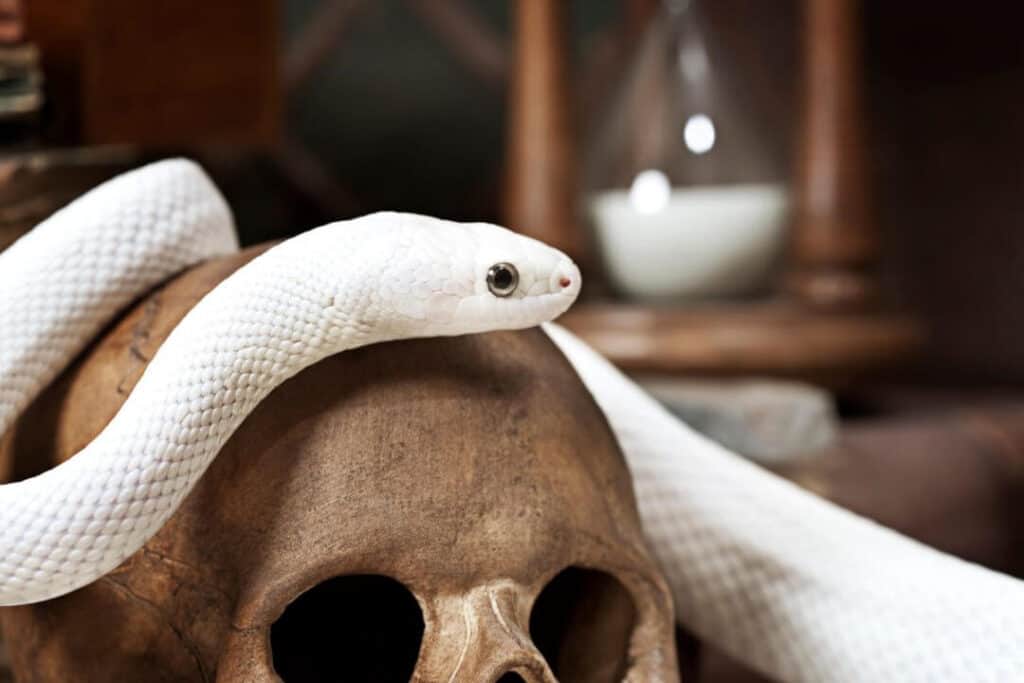
The Snowflake Leucistic Texas rat snake is a slender-bodied snake that can reach 5 to 6 feet in length.
The Snowflake Leucistic rat snake exhibits a beautiful white coloration all along the length of the snake making for a truly strikingly beautiful animal!
Rat snakes are great eaters and will readily accept most foods; that along with their ease of care and hardiness make them excellent for beginner and novice reptile keepers.
Leucistic Cobra
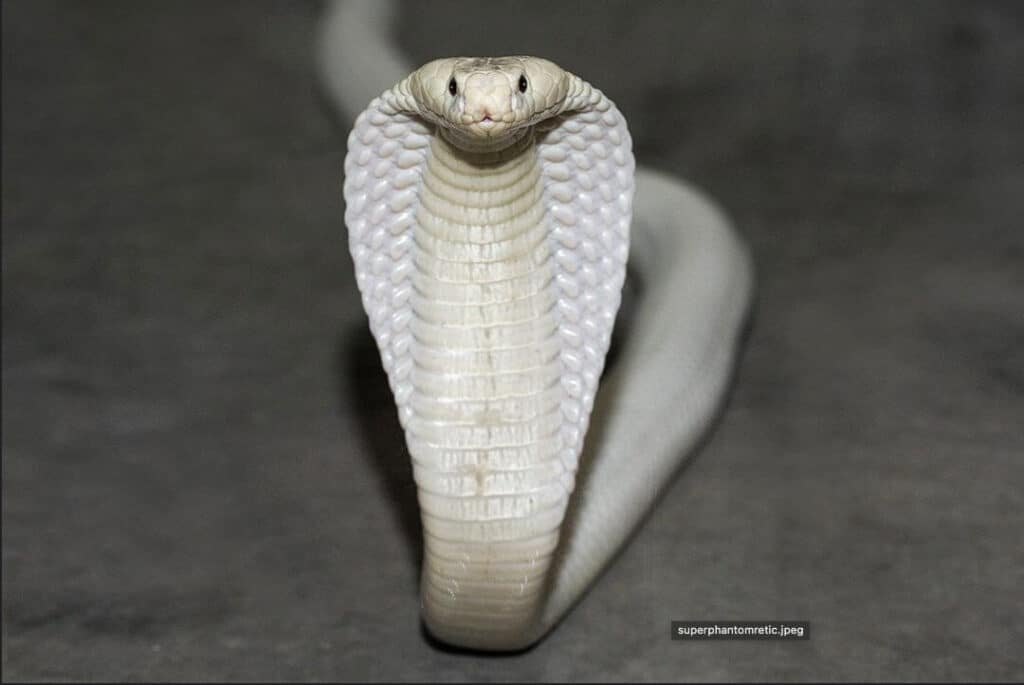
Beginner reptile keepers need not apply! The Leucistic cobra is definitely one white snake that is for very experienced to expert keepers only! Cobras are venomous reptiles powerful enough to kill a human with its bite.
That said, an all-white (leucistic) cobra is a spectacular sight to behold! Both deadly and breathtakingly beautiful at teh same time!

